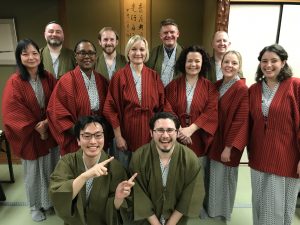 Easily my best week of 2020 was the brilliantly-organised Japan Study Tour of Tsu City and Tokyo run by the Council of Local Authorities for International Relations (CLAIR).
Easily my best week of 2020 was the brilliantly-organised Japan Study Tour of Tsu City and Tokyo run by the Council of Local Authorities for International Relations (CLAIR).
I was lucky enough to be one of the eight UK participants of the annual local government exchange in January, just as coronavirus was emerging as a public health issue in China. It was only with the benefit of hindsight that I realised the significance of the staff temperature-checking visitors arriving at Narita airport and the ordinariness of everyone wearing face coverings. I certainly could not have foreseen the challenging year that lay ahead for the entire world and the ‘happy place’ that Japan and my experiences would be for me personally to help sustain me through the difficulties of 2020. I’m sad to learn that the pandemic has affected the planned Study Tour for January 2021 and hope that it will be able to go ahead again soon so that others can benefit from this fabulous programme.
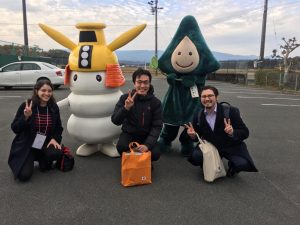 We were given a wonderfully warm welcome in both Tokyo and Tsu City and had an amazing experience learning about the similarities and differences between Japan and the UK, in terms of our systems of local government and culture. We exchanged ideas, gifts and business cards and made some important and enduring connections, including with our incredible CLAIR guides and each other.
We were given a wonderfully warm welcome in both Tokyo and Tsu City and had an amazing experience learning about the similarities and differences between Japan and the UK, in terms of our systems of local government and culture. We exchanged ideas, gifts and business cards and made some important and enduring connections, including with our incredible CLAIR guides and each other.
As 2020 unfolded, one of the hot topics in the UK (on top of the pandemic and Brexit) has been devolution. There has been much discussion about how councils could work together to deliver services and boost growth across functional economic geographies that make sense to residents and businesses. This is big in Japan. How might turning Japanese aid our progress on devolution?
On our first full day in Tokyo, we learned from Professor Kimura of Meiji University that Japan has a two-tier system of local government comprising prefectures, broadly equivalent to our counties, and municipalities, akin to our district councils but actually cities, towns or villages of varying sizes depending on the local functional economic geography – the largest being Yokahama City with a population of 3.7 million and the smallest being Aogashima Island with only 150 people.
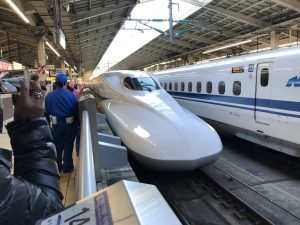 Modern Japan has been through three periods of local government consolidation, with district mergers to achieve efficiency and economies of scale. Decentralisation and devolution has resulted in counties and districts largely independent of central government, each with considerable tax-raising powers to fund their activities. However, central government collects a proportion of local taxes which it redistributes according to a formula to balance out the different tax-raising abilities of the variously-sized councils. We were told that getting the formula right is a big headache for the Ministry of Internal Affairs. Overall, the Japanese accept a considerable tax burden which is not so palatable here in the UK.
Modern Japan has been through three periods of local government consolidation, with district mergers to achieve efficiency and economies of scale. Decentralisation and devolution has resulted in counties and districts largely independent of central government, each with considerable tax-raising powers to fund their activities. However, central government collects a proportion of local taxes which it redistributes according to a formula to balance out the different tax-raising abilities of the variously-sized councils. We were told that getting the formula right is a big headache for the Ministry of Internal Affairs. Overall, the Japanese accept a considerable tax burden which is not so palatable here in the UK.
In Japan, devolution in a two-tier system appears to work harmoniously and well. District councils work at a scale that is meaningful for local residents and businesses, enjoy considerable autonomy, and have fundraising powers and certainty of finance to enable them to deliver services and boost growth. Every district also has an elected mayor, which has been a contentious issue in much of the UK. With greater fiscal freedom from central government, could we achieve the same here in the UK?
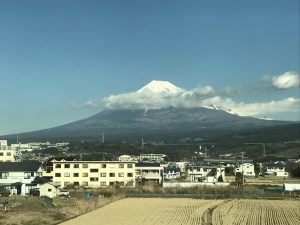 Greater planning freedoms than exist in the UK were also evident in Japan. In Tsu City, we visited the Aoyama Wind Farm and its impressive range of wind turbines set in an attractive mountainous landscape. Whilst my own similarly hilly district, Stroud, is the home of Ecotricity who manufacture wind turbines in the UK, there are only a handful of turbines in the district itself as much of it is in the Cotswolds Area of Outstanding Natural Beauty where it just wouldn’t be possible to get planning permission.
Greater planning freedoms than exist in the UK were also evident in Japan. In Tsu City, we visited the Aoyama Wind Farm and its impressive range of wind turbines set in an attractive mountainous landscape. Whilst my own similarly hilly district, Stroud, is the home of Ecotricity who manufacture wind turbines in the UK, there are only a handful of turbines in the district itself as much of it is in the Cotswolds Area of Outstanding Natural Beauty where it just wouldn’t be possible to get planning permission.
The pragmatic juxtaposition of the ancient and modern in Japan is also fascinating. We were impressed by the magnificence of the Senju-ji Temple, where four of the six ‘National Treasure buildings’ in Mie prefecture are located, but looking around, it is set amongst earthquake-resistant plain buildings which are typical of post-war reconstruction. The system of planning ‘zones’ that apply in Japan, where the type but not the design of development is a factor, is currently under consideration here in the UK.
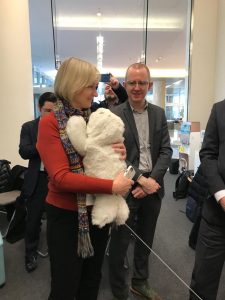 A challenge that we share with Japan is an ageing population and the draw of the larger cities for younger people, resulting in social isolation in more rural areas and a shortage of people to provide care for the elderly. In Tsu City we learned about the innovative way that this is being tackled. The ‘Nutrition Patrol’ involves interventions to improve diet, guarding against malnutrition and deterioration of physical and mental functions, and is about wrapping community support around the elderly, teaching the men to cook and avoiding seniors eating alone too often. There are also ‘Stay Sprightly’ exercise classes and bus pass schemes that mirror our own, as well as Fureai-Ikiiki salon projects (community gathering spots). It is the emphasis on prevention and inclusion that is thought-provoking, particularly as we reflect on the impact of the pandemic and the heightened sense of social responsibility and community that it has brought to the UK.
A challenge that we share with Japan is an ageing population and the draw of the larger cities for younger people, resulting in social isolation in more rural areas and a shortage of people to provide care for the elderly. In Tsu City we learned about the innovative way that this is being tackled. The ‘Nutrition Patrol’ involves interventions to improve diet, guarding against malnutrition and deterioration of physical and mental functions, and is about wrapping community support around the elderly, teaching the men to cook and avoiding seniors eating alone too often. There are also ‘Stay Sprightly’ exercise classes and bus pass schemes that mirror our own, as well as Fureai-Ikiiki salon projects (community gathering spots). It is the emphasis on prevention and inclusion that is thought-provoking, particularly as we reflect on the impact of the pandemic and the heightened sense of social responsibility and community that it has brought to the UK.
I don’t think any of us will forget some of the innovative care assistance devices for the elderly that we road-tested at the housing company Daiwa House in Tokyo. Many of the aids were designed to reduce the need for scarce human carers. These included automatic beds-to-chairs, electric wheelchairs and our cuddly favourite PARO the therapeutic robot seal, who has been shown to reduce stress in the elderly in the same way that pet therapy does. It reminded me of how my father, who suffered from dementia in his last years, reached out to stroke an invisible deer for solace at difficult moments.
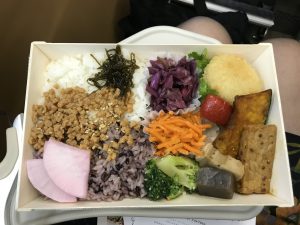 For me, many of the cultural highlights of our week involved food. This ranged from a bento box on a bullet train rocketing past scenic Mount Fuji, to tasting soya products produced by an inspirational female-led family firm in Tsu, through to gyoza bars and the fabulous formal dinners we were treated to by CLAIR and our host cities. Perhaps the most memorable was the traditional meal we enjoyed at the Sakakibara Hot Springs, a traditional Japanese inn with futon mattress beds rolled out onto tatami-mat floors, following a dip in the onsen (hot bath). The etiquette surrounding taking a public bath and the meal itself were quite an education. We were terrified of offending other guests by wrapping our yukata around ourselves in the wrong way – overlapping right on left is only used to dress a corpse for burial – and pointing your chopsticks at others and pouring a drink for yourself is considered rude. We tried hard to match the politeness and good manners of our hosts.
For me, many of the cultural highlights of our week involved food. This ranged from a bento box on a bullet train rocketing past scenic Mount Fuji, to tasting soya products produced by an inspirational female-led family firm in Tsu, through to gyoza bars and the fabulous formal dinners we were treated to by CLAIR and our host cities. Perhaps the most memorable was the traditional meal we enjoyed at the Sakakibara Hot Springs, a traditional Japanese inn with futon mattress beds rolled out onto tatami-mat floors, following a dip in the onsen (hot bath). The etiquette surrounding taking a public bath and the meal itself were quite an education. We were terrified of offending other guests by wrapping our yukata around ourselves in the wrong way – overlapping right on left is only used to dress a corpse for burial – and pointing your chopsticks at others and pouring a drink for yourself is considered rude. We tried hard to match the politeness and good manners of our hosts.
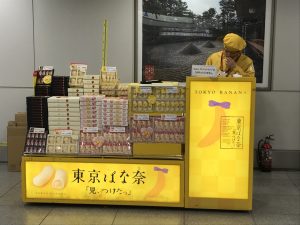 The rush for banana cakes at Tokyo Station and our trawl of perpetually open convenience stores for different-flavoured Kit-Kats and savoury snacks to match the taste of the ‘abandoned noodles’ (pot noodle leftover scrapings) that we enjoyed on the Tsu City bus tour, along with taking gyoza selfies, will stay with me for a long time.
The rush for banana cakes at Tokyo Station and our trawl of perpetually open convenience stores for different-flavoured Kit-Kats and savoury snacks to match the taste of the ‘abandoned noodles’ (pot noodle leftover scrapings) that we enjoyed on the Tsu City bus tour, along with taking gyoza selfies, will stay with me for a long time.
I also found the proliferation of mascots to promote places, regions, businesses and events intriguing. I met my first one, an oversized red bird, on landing at Narita airport and at Aoyama we were greeted by Shiromochi-kun, a rice cake with a Samurai helmet, and Misugin, a tree fairy. They are great fun and these yuru-kyara are a lot like the fantastic Japanese people we met – “gentle characters”, who become a lot more raucous when you’re with them in a karaoke booth. I can’t wait for the opportunity to go back to Japan as a tourist – I have a yen to return as soon as travel restrictions are lifted.
 Kathy O’Leary, Chief Executive, Stroud District Council, JST 2020 Participant
Kathy O’Leary, Chief Executive, Stroud District Council, JST 2020 Participant
For more details on the tour as they become available, as well as our other events and activities, please follow us on LinkedIn, Facebook and Twitter for updates.

